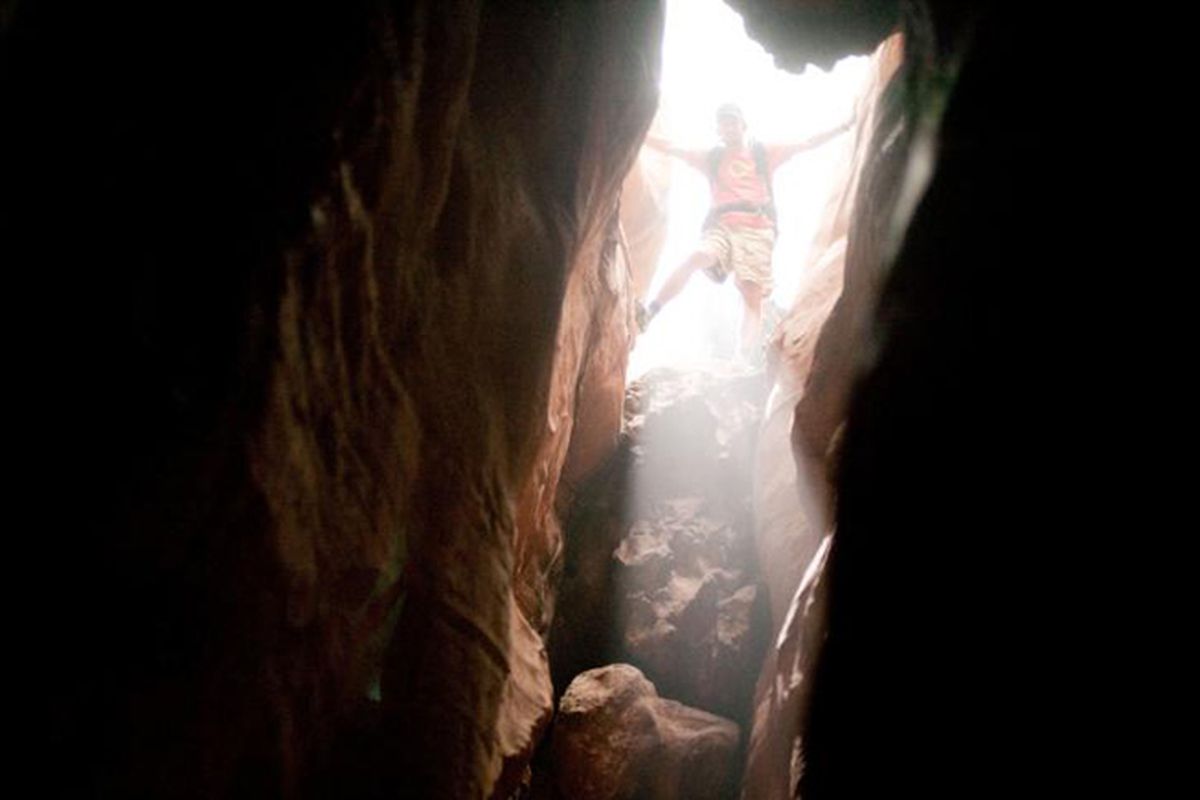Self-amputation scene cuts to the bone of Ralston’s will to live

Aron Ralston has watched his arm cut off dozens of times.
It’s the most controversial scene of the new film “127 Hours,” a fictional account based on Ralston’s 2003 solo canyoneering trip gone wrong in southern Utah’s narrow Bluejohn Canyon.
What had been the most intimate of experiences, which Ralston recounted in his 2004 memoir, “Between a Rock and a Hard Place,” will be seen, and judged, by millions of filmgoers.
The movie premiered Nov. 3 and is scheduled to reach Spokane this week.
“The initial intensity comes back in so many vivid ways every time I go back (to the canyon) or see the film,” said Ralston, who lives in Colorado and has returned 10 times to the Utah slot canyon where he left his right arm, half of those trips while helping with the film.
At early screenings, some filmgoers reported feeling light-headed while others have left the theater during the scene when actor James Franco, who plays Ralston, saws off his pinned appendage with a dull multitool.
Most Westerners will remember Ralston’s story: What began as a casual solo adventure on April 26, 2003, left the then-27-year-old man stuck in the slot canyon just outside Canyonlands National Park. After an 800-pound boulder pinned his arm against a sandstone wall, Ralston was trapped for what stretched to 5½ days.
“There was the euphoric feeling of being free and getting my life back again,” Ralston said last week. “Because of what happened, I understand what life is.”
What’s compelling, he believes, isn’t the actual self-amputation, but the motivation to do so, and the deep reach of his desire to live.
“I’m hopeful that people will see something inside of themselves, as well,” said Ralston, who doesn’t believe words such as “courageous” or “heroic” apply to him.
“I was in an extraordinary circumstance and it fundamentally came down to wanting to live and get back to my family. It is about survival, love and freedom – and those things are common in all of us.”
Most of the drama of Ralston’s experience could have been avoided. A simple note to one person about where he was headed on that spring day and when he’d return might have sufficed. Traveling with at least one other person may not have saved his arm, but it could have prevented 5½ days of waiting to die.
“There are a whole variety of reasons to go solo,” Ralston said, noting the freedom it allows. “You find a greater connection with the wilderness, as opposed to connecting with a companion in the wilderness. I am grateful for companionship in the wild, especially now, but I also still feel a need to prove to myself that I am capable and self-reliant.”
That he survived the amputation of his right arm is more amazing considering the mental trickery involved along with dehydration and delirium he suffered from a lack of water, food and sleep.
Being a mechanical engineer may have helped Ralston with the intricate process of deciding on the most efficient way to cut off his own arm. How many people, in a similarly desperate state, would realize they had to break both bones in their lower arm before starting the procedure?
Ralston had snapped photos during his ordeal and paused to take a picture of the rock walls where he had inscribed what he thought would be his death date, then escaped Bluejohn Canyon by leaving his arm behind.
His next challenge, as a rookie amputee, was wedging down the rest of the slot canyon and surviving a 150-foot rappel. That tricky maneuver completed, Ralston embarked on the 8-mile journey into Canyonlands National Park where his truck was parked.
Two miles into the hike, shortly after passing the Great Galley pictograph panel, he ran into a tourist family from Holland. They offered him water and two Oreo cookies — apologizing for having eaten most of their stash of cookies.
Ralston was relieved for the nourishment and company, but feared he was too weak to survive the rest of the hike.
Rescuers eventually got word and rescued him with a helicopter.
When medics took over and Ralston finally dropped into a drug-induced sleep, Canyonlands National Park Ranger Steve Swanke made his favorite kind of call during search-and-rescue assignments — to Donna Ralston.
“I have good news and bad news,” Swanke told Ralston’s mother. “He is alive, but he’s missing an arm.”
News of the story spread across the planet. People talked about whether they could do the same thing. The park was besieged with calls. The Internet buzzed with postings from people who considered heading to Bluejohn, retrieving Ralston’s right arm, and then putting it up for auction on eBay.
Such discussions prompted National Park Service officials to recover the appendage.
Ralston’s arm was delivered to a mortuary in Moab, where it was cremated and the remains sent to their owner. Six months later, “Dateline NBC” brought Ralston back to the canyon for a news story. When the filming was complete, Ralston spent time alone.
After scattering the ashes of his arm in Bluejohn Canyon, he set about removing the inscription he had carved when he was near death: “RIP OCT 75 ARON APR 03.”
Ralston makes a living nowadays largely from giving motivational talks. He said he holds no grudges against his beloved wilderness. Rather, he has a greater desire to protect wildlands, particularly those in southern Utah he considers threatened.
While working with “127 Hours” producers, he retraced his steps in the canyon. Surrounded by redrocks, he greeted the canyon walls, his old, intimate yet disinterested acquaintance, as though it were a distant cousin or high-school chum.
On his digital camera’s viewing screen, he pulled up a photo that represented his born-again life: a picture of Leo, his 9-month-old son.
“I showed it to the rock,” Ralston said. “I said, ‘Look who is here now.’ ”